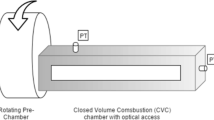Abstract
The objective of new combustion concepts is to meet emission standards by improving fuel air mixing prior to ignition. Since there is no overlap between injection and ignition, combustion is governed mainly by chemical kinetics and it is challenging to control the phasing of ignition. Reactivity Controlled Compression Ignition (RCCI) combustion aims to control combustion phasing by altering the fuel ratios of the high- and low octane fuel and injection timings. In this study the dual fuel blend is prepared with gasoline and diesel fuels. The applied injection timings of the diesel are very early (90 to 60° CA bTDC). In the detailed reaction mechanism, n-heptane and iso-octane represent diesel and gasoline fuel, respectively. A multi-zone model approach is implemented to perform RCCI combustion simulation. Ignition characteristics are analyzed by using CA50 as the main parameter. In the experiments for the early direct injection (DI) timing advancing the injection time results in a later ignition. Qualitatively, the trend effect of the diesel injection timing and the effect of the ratio gasoline/diesel are captured accurately by the multi-zone model.
Similar content being viewed by others
References
Andrae, J. C. G., Brinck, T. and Kalghatgi, G. T. (2008). HCCI experiments with toluene reference fuels modeled by a semi-detailed chemical kinetic model. Combustion and Flame, 155, 696–712.
Egüz, U., Somers, L. M. T., Leermakers, C. A. J. and de Goey, L. P. H. (2010). Multi-zone modeling of PCCI combustion. Int. J. Vehicle Design, 55, 76–90.
Egüz, U., Ayyapureddi, S., Bekdemir, C., Somers, L. M. T. and de Goey, L. P. H. (2012). Modeling fuel spray autoignition using the FGM approach: Effect of tabulation method. SAE Paper No. 2012-01-0157.
Hohenberg, G. F. (1979). Advanced approaches for heat transfer calculations. SAE Paper No. 790825.
Komninos, N. P. (2009). Assessing the effect of mass transfer on the formation of HC and CO emissions in HCCI engines, using a multi-zone model. Energy Conversion and Management, 50, 1192–1201.
Leermakers, C., Van den Berge, B., Luijten, C., Somers, L., de Goey, L. P. H. and Albrecht, B. A. (2011). Gasolinediesel dual fuel: Effect of injection timing and fuel balance. SAE Paper No. 2011-01-2437.
Maiboom, A., Tauzia, X., Shah, S. R. and Hetet, J. F. (2009). New phenomenological six-zone combustion model for direct-injection diesel engines. Energy & Fuels, 23, 690–703.
Manente, V., Johansson, B., Tunestal, P. and Cannella, W. (2010a). Influence of inlet pressure, EGR, combustion phasing, speed and pilot ratio on high load gasoline partially premixed combustion. SAE Paper No. 2010-01-1471.
Manente, V., Tunestal, P., Johansson, B. and Cannella, W. (2010b). Effects of ethanol and different type of gasoline fuels on partially premixed combustion from low to high load. SAE Paper No. 2010-01-0871.
Nobakht, A. Y., Saray, R. K. and Rahimi, A. (2011). A parametric study on natural gas fueled HCCI combustion engine using a multi-zone combustion model. Fuel, 90, 1508–1514.
Ogink, R. and Golovitchev, V. (2005). Gasoline HCCI modeling: An engine cycle simulation code with a multizone combustion model. SAE Paper No. 2002-01-1745.
Poetsch, C., Ofner, H. and Schutting, E. (2011). Assessment of a multi zone combustion model for analysis and prediction of CI engine combustion and emissions. SAE Paper No. 2011-01-1439.
Rakopoulos, C. D., Michos, C. N. and Giakoumis, E. G. (2008). Availability analysis of a syngas fueled spark ignition engine using a multi-zone combustion model. Energy, 33, 1378–1398.
Sahin, Z. and Durgun, O. (2008). Multi-zone combustion modeling for the prediction of diesel engine cycles and engine performance parameters. Applied Thermal Engineering, 28, 2245–2256.
Somers, L. M. T., Evlampiev, A. E. and de Goey, L. P. H. (2007). Modelling auto-ignition of automotive fuels using detailed mechanisms. Proc. Combustion Institute.
Van Oijen, J. A. and De Goey, L. P. H. (2004). A numerical study of confined triple flames using a flamelet-generated manifold. Combustion Theory Modelling, 8, 141–163.
Xu, H., Liu, M., Gharahbaghi, S., Richardson, S., Wyszynski, M. and Megaritis, T. (2005). Modeling of HCCI engines: Comparison of single-zone, multi-zone and test data. SAE Paper No. 2005-01-2123.
Author information
Authors and Affiliations
Corresponding author
Rights and permissions
About this article
Cite this article
Egüz, U., Maes, N.C.J., Leermakers, C.A.J. et al. Predicting auto-ignition characteristics of RCCI combustion using a multi-zone model. Int.J Automot. Technol. 14, 693–699 (2013). https://doi.org/10.1007/s12239-013-0075-2
Received:
Revised:
Accepted:
Published:
Issue Date:
DOI: https://doi.org/10.1007/s12239-013-0075-2




